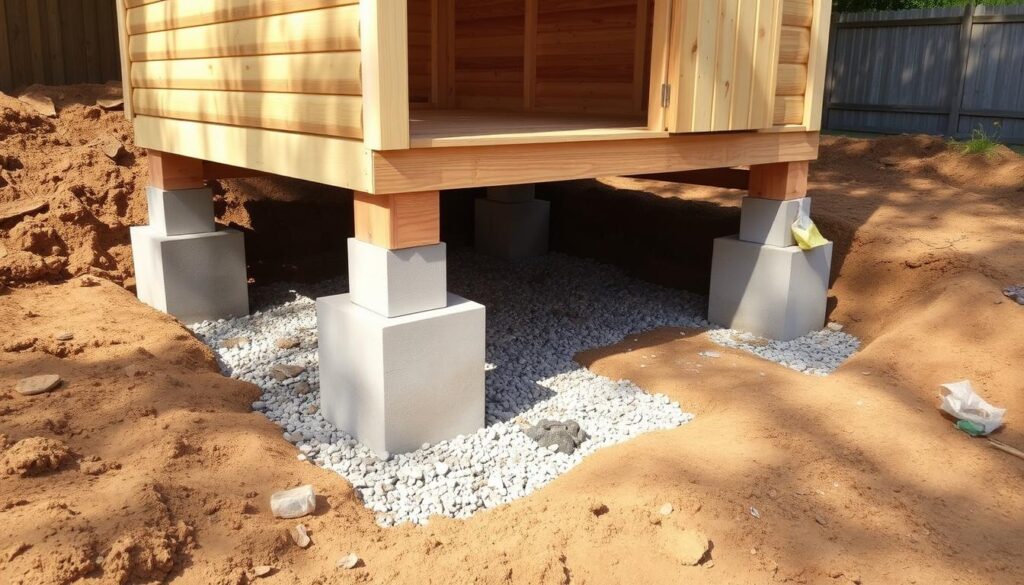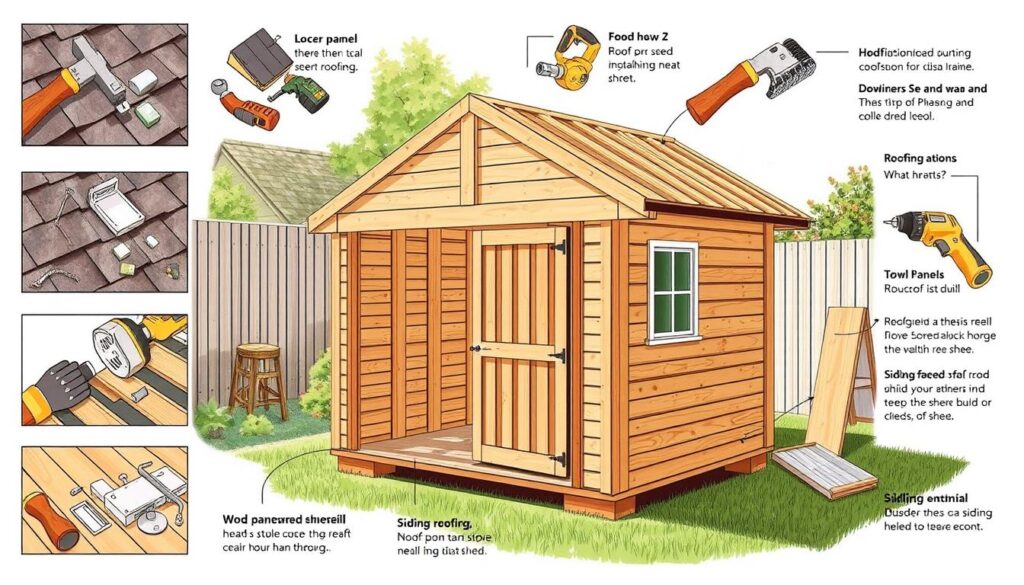Building a shed from scratch can save you money. Costs vary based on materials and tools. A small, basic shed is a great DIY project. With the right guidance, you can learn to build a shed step by step.
Before starting, think about your shed’s size and style. A typical shed is 8 feet by 12 feet. This size offers a lot of space for storage. Following a step-by-step guide ensures your shed is durable and meets your needs.
Key Takeaways
- Building a shed from scratch can be a cost-effective DIY project
- Proper planning and preparation are essential for a successful shed building project
- A typical shed size is 8 feet by 12 feet, with a 48-inch door and one window
- Step-by-step shed construction techniques can help you build a shed that meets your needs
- Diy shed building requires careful consideration of materials and tools
- How to build a shed from scratch involves careful planning and execution
- Step-by-step shed construction guides can help you navigate the building process
Planning Your Shed Project
Planning is crucial when building a shed. It sets the stage for a successful project. First, think about the location, size, and style of your shed. Also, check if you need any permits.
Shed building tips suggest choosing a spot that’s level, well-drained, and easy to get to. Consider the shed design ideas that fit your needs and available space. Think about what you’ll use the shed for.
Choosing the right shed building materials is also important. This includes lumber, roofing, and siding. Don’t forget about windows and doors. Selecting the right materials ensures your shed is strong, useful, and meets your requirements.
Here are some key factors to consider when planning your shed project:
- Location: Choose a spot that is level, well-drained, and accessible.
- Size: Determine the size of your shed based on your needs and the space available.
- Style: Consider the style of your shed, including the type of roofing, siding, and doors.
- Permits: Check with your local authorities to determine if any permits are required.
By planning well, you can finish your shed on time and within budget. Remember to use shed building tips, shed design ideas, and shed building materials to make your project a success.
Essential Tools and Materials Needed
Building a shed requires the right tools and materials. Shed building materials depend on the shed’s size and design. You’ll need lumber, plywood, and roofing materials. Also, shed building techniques like framing and roofing are key for a safe build.
Here’s a list of tools you’ll need to start:
- Safety glasses
- Tape measure
- Circular saw
- Speed square
- Hammer
- Level
- Sawhorses
- Drill
- Ladders
A circular saw is vital for cutting shed parts. A speed square helps with angle measurements. A framing nailer is great for saving time when framing.
| Tool | Description |
|---|---|
| Circular saw | Used for making essential cuts on various shed components |
| Speed square | Used for angle measurements |
| Framing nailer | Used for framing the shed, can save time and effort |
Preparing the Construction Site
Preparing the site for a backyard shed is key. It involves leveling the ground, picking the right foundation, and thinking about drainage. A good site ensures a strong and lasting shed foundation.
To start, leveling the ground is crucial. Remove any debris, plants, or blocks from the area. A gravel base for a shed costs between $5.00 and $9.00 per square foot. You’ll need about 3 to 4 cubic yards of gravel for the foundation.
- Ensuring the ground is level for proper installation and longevity of the shed foundation
- Choosing the right foundation, such as a gravel base or concrete slab
- Considering drainage to prevent water accumulation around the shed
By following these steps, you can get your site ready for your shed project. This will lead to a successful shed building experience.
How to Build a Shed Foundation
A solid shed foundation is key to avoid rot from moisture and ensure a stable base. When building a shed, picking the right foundation is vital. You have options like on-grade, frost-proof, and skid foundations. On-grade foundations are simple and don’t need digging or concrete, perfect for small sheds.
For bigger sheds, frost-proof foundations are better because they last longer. They need digging below the frost line, which changes by area, to stop frost damage. Using concrete deck blocks and crushed stone can make a strong foundation. Think about the soil type and shed size when picking a foundation.

- Concrete paver foundations, which are budget-friendly and suitable for small sheds
- Treated wood frame foundations, which can be filled with gravel for proper drainage
- Pressure-treated wood grids, which provide sufficient stability and flexibility
It’s crucial to make sure your foundation is level and firm. This prevents problems like doors sticking and gaps between wall boards. By following a shed construction guide and using the right shed building techniques, you can build a strong foundation for your shed. It will last for many years.
Framing the Walls and Structure
Framing the walls and structure is key in step-by-step shed construction. This step includes building wall frames, adding doors and windows, and putting together the roof truss. It’s vital to use the right shed building materials and methods for a safe and strong build.
Wall frames usually have horizontal top and bottom plates, vertical studs, and headers above windows and doors. It’s important to use pressure-treated lumber for parts touching the ground or concrete. For a standard shed, studs are 16 inches apart, with headers made from two-by-eights and plywood.
- Using scrap pieces of 2×4 for constructing blocks to reduce materials costs
- Installing diagonal bracing to enhance stability
- Ensuring proper nail spacing for structural integrity
By following these steps and using the correct shed building materials, you can build a strong and lasting shed. It will stand up to the weather and serve you well for many years.
Installing Roofing and Siding
Installing roofing and siding is key to a safe and successful shed build. A shed construction guide offers insights into the process. It covers using asphalt shingles and T1-11 siding.
Sheet siding is a popular choice. It comes in 4×8 sheets and is available in 1/2″ and 5/8″ thicknesses. This siding is durable and easy to install.
The installation process needs careful attention. Use 8d galvanized nails to prevent rust. Space them 6 inches on center around edges and 12 inches in the center.
Sheet siding grooves can be 4 inches or 8 inches apart. Z metal flashing is used to keep water out.

- Cost: O.S.B. siding is generally less expensive than T1-11 plywood siding
- Durability: Composite siding made from cement is resistant to rot and very stable
- Lifespan: Unpainted galvanized sheet metal roofing can last over 50 years, while asphalt shingles typically last around 20 years
By following a detailed shed construction guide and using proper shed building techniques, you can achieve a successful build. Consider cost, durability, and lifespan when choosing materials.
| Material | Cost | Durability | Lifespan |
|---|---|---|---|
| O.S.B. Siding | Less expensive | Less stable than T1-11 | Varies |
| T1-11 Plywood Siding | More expensive | More stable than O.S.B. | Varies |
| Composite Siding | Varies | Very stable | Long-lasting |
Adding Doors and Windows
Adding doors and windows to your shed requires careful planning. You need to think about your design ideas and the materials you’ll use. Getting these right is key for both function and looks.
For doors, make sure they’re level and well-attached. Use long screws to fix the jamb to the frame. Also, ensure the door slab sticks out ¾ inch for proper alignment with siding. Windows should be placed and sized right to let in more light and make the space more useful.
Door Installation Guide
Here’s how to install doors correctly:
- Prepare the door frame and ensure it is level
- Attach the door slab to the frame using hinges and screws
- Install the door handles and locking mechanism
Window Placement Tips
For windows, keep these tips in mind:
- Position them to maximize natural light and ventilation
- Ensure they are securely attached to the frame using pan-head screws
- Consider the size and type of windows that will best suit your shed design ideas
By following these steps and choosing the right materials, you can build a shed that’s both useful and looks great. It will enhance your outdoor area.
| Material | Cost per Unit |
|---|---|
| Pressure-treated lumber | $2 to $5 per board foot |
| Metal roofing | $3 to $6 per square foot |
| Asphalt shingles | $0.90 to $2.50 per square foot |
Weather Protection and Finishing Touches
Building a shed means making sure it can handle different weather. Weather protection and finishing touches are key. With the right tips, your shed will last a long time. Also, consider off grid solutions for electricity.
First, protect your shed’s outside from the weather. Use waterproof sealants, install gutters, and apply a wood coat. Paint or enamel can also help protect the wood. Using materials like featheredge boards and felt shingles adds extra protection.
Interior Organization Solutions
Keeping your shed’s inside organized is just as important. Use shelves, hooks, and bins to keep things neat. Add a workbench or potting station for a functional space. These tips help make your shed both useful and nice to look at.
Paint and Preservation
Keeping your shed’s wood in good shape is vital. Use a wood preservative to fight rot and bugs. A coat of paint or stain can also protect and look good. These tips help your shed last for many years.
Conclusion: Maintaining Your New Shed
Now that your building a storage shed is done, it’s time to keep it in top shape. Taking good care of it is key to keeping it looking and working great. Regular checks, cleaning, and fixing things quickly will make your shed last for a long time.
First, look over the shed’s outside for any cracks, warping, or loose parts. Fixing these problems right away helps avoid bigger issues and keeps your stuff safe. Also, clean the roof, gutters, and walls often to stop moisture and pests.
Don’t forget to paint or seal the shed every few years to protect it from the weather. Using the right weatherproofing methods, like good ventilation and fixing leaks, will also help your shed last longer.
By spending a bit of time on upkeep, your custom-built shed will stay a valuable and useful part of your property for many years.

